Case Study Analysis: Woolworths' Strategies, Change, and Innovation
VerifiedAdded on 2022/10/19
|12
|2771
|395
Case Study
AI Summary
This case study analyzes Woolworths' strategic responses to the dynamic business environment, focusing on their adoption of innovative strategies and change management practices. It explores both the external and internal factors driving the need for change, including market pressures, technological advancements, and internal organizational dynamics. The study examines Woolworths' application of Kurt Lewin's Change Management Model to mitigate employee resistance and facilitate the integration of new strategies. Furthermore, the analysis delves into the human resource strategies employed by Woolworths, such as recruitment, training, and performance management, to foster a skilled and adaptable workforce. The study highlights how Woolworths integrates future strategies, including AI and lean retail models, to enhance customer experience, drive efficiency, and maintain a competitive edge. The conclusion emphasizes the importance of continuous innovation, effective HR management, and strategic alignment for sustained business success. The document provides valuable insights into how Woolworths navigates the complexities of the retail industry and adapts to evolving consumer demands.

Case Study Analysis 0
Case Study Analysis
Student’s Name
9/23/2019
Case Study Analysis
Student’s Name
9/23/2019
Paraphrase This Document
Need a fresh take? Get an instant paraphrase of this document with our AI Paraphraser
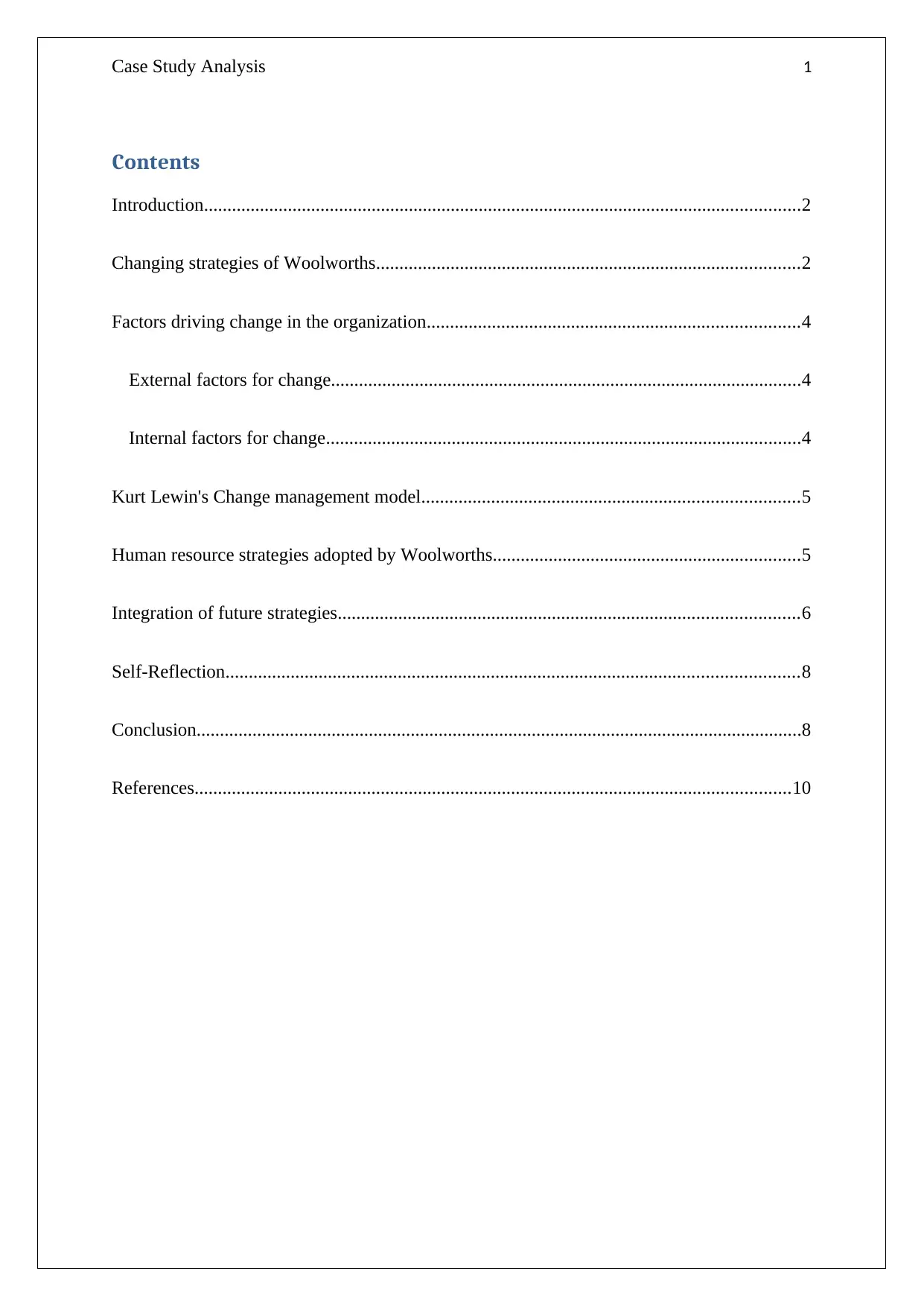
Case Study Analysis 1
Contents
Introduction................................................................................................................................2
Changing strategies of Woolworths...........................................................................................2
Factors driving change in the organization................................................................................4
External factors for change.....................................................................................................4
Internal factors for change......................................................................................................4
Kurt Lewin's Change management model.................................................................................5
Human resource strategies adopted by Woolworths..................................................................5
Integration of future strategies...................................................................................................6
Self-Reflection...........................................................................................................................8
Conclusion..................................................................................................................................8
References................................................................................................................................10
Contents
Introduction................................................................................................................................2
Changing strategies of Woolworths...........................................................................................2
Factors driving change in the organization................................................................................4
External factors for change.....................................................................................................4
Internal factors for change......................................................................................................4
Kurt Lewin's Change management model.................................................................................5
Human resource strategies adopted by Woolworths..................................................................5
Integration of future strategies...................................................................................................6
Self-Reflection...........................................................................................................................8
Conclusion..................................................................................................................................8
References................................................................................................................................10
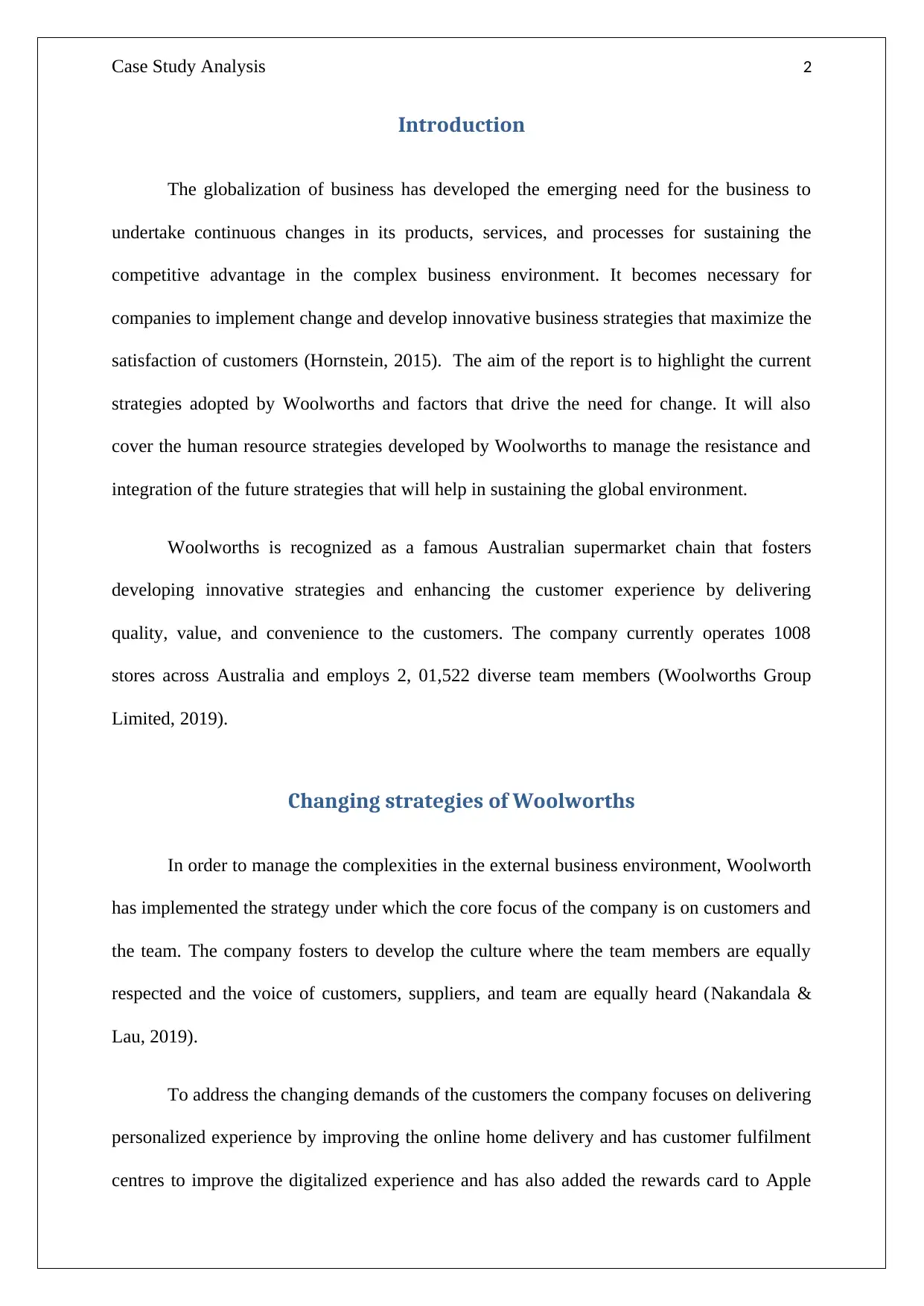
Case Study Analysis 2
Introduction
The globalization of business has developed the emerging need for the business to
undertake continuous changes in its products, services, and processes for sustaining the
competitive advantage in the complex business environment. It becomes necessary for
companies to implement change and develop innovative business strategies that maximize the
satisfaction of customers (Hornstein, 2015). The aim of the report is to highlight the current
strategies adopted by Woolworths and factors that drive the need for change. It will also
cover the human resource strategies developed by Woolworths to manage the resistance and
integration of the future strategies that will help in sustaining the global environment.
Woolworths is recognized as a famous Australian supermarket chain that fosters
developing innovative strategies and enhancing the customer experience by delivering
quality, value, and convenience to the customers. The company currently operates 1008
stores across Australia and employs 2, 01,522 diverse team members (Woolworths Group
Limited, 2019).
Changing strategies of Woolworths
In order to manage the complexities in the external business environment, Woolworth
has implemented the strategy under which the core focus of the company is on customers and
the team. The company fosters to develop the culture where the team members are equally
respected and the voice of customers, suppliers, and team are equally heard (Nakandala &
Lau, 2019).
To address the changing demands of the customers the company focuses on delivering
personalized experience by improving the online home delivery and has customer fulfilment
centres to improve the digitalized experience and has also added the rewards card to Apple
Introduction
The globalization of business has developed the emerging need for the business to
undertake continuous changes in its products, services, and processes for sustaining the
competitive advantage in the complex business environment. It becomes necessary for
companies to implement change and develop innovative business strategies that maximize the
satisfaction of customers (Hornstein, 2015). The aim of the report is to highlight the current
strategies adopted by Woolworths and factors that drive the need for change. It will also
cover the human resource strategies developed by Woolworths to manage the resistance and
integration of the future strategies that will help in sustaining the global environment.
Woolworths is recognized as a famous Australian supermarket chain that fosters
developing innovative strategies and enhancing the customer experience by delivering
quality, value, and convenience to the customers. The company currently operates 1008
stores across Australia and employs 2, 01,522 diverse team members (Woolworths Group
Limited, 2019).
Changing strategies of Woolworths
In order to manage the complexities in the external business environment, Woolworth
has implemented the strategy under which the core focus of the company is on customers and
the team. The company fosters to develop the culture where the team members are equally
respected and the voice of customers, suppliers, and team are equally heard (Nakandala &
Lau, 2019).
To address the changing demands of the customers the company focuses on delivering
personalized experience by improving the online home delivery and has customer fulfilment
centres to improve the digitalized experience and has also added the rewards card to Apple
⊘ This is a preview!⊘
Do you want full access?
Subscribe today to unlock all pages.

Trusted by 1+ million students worldwide
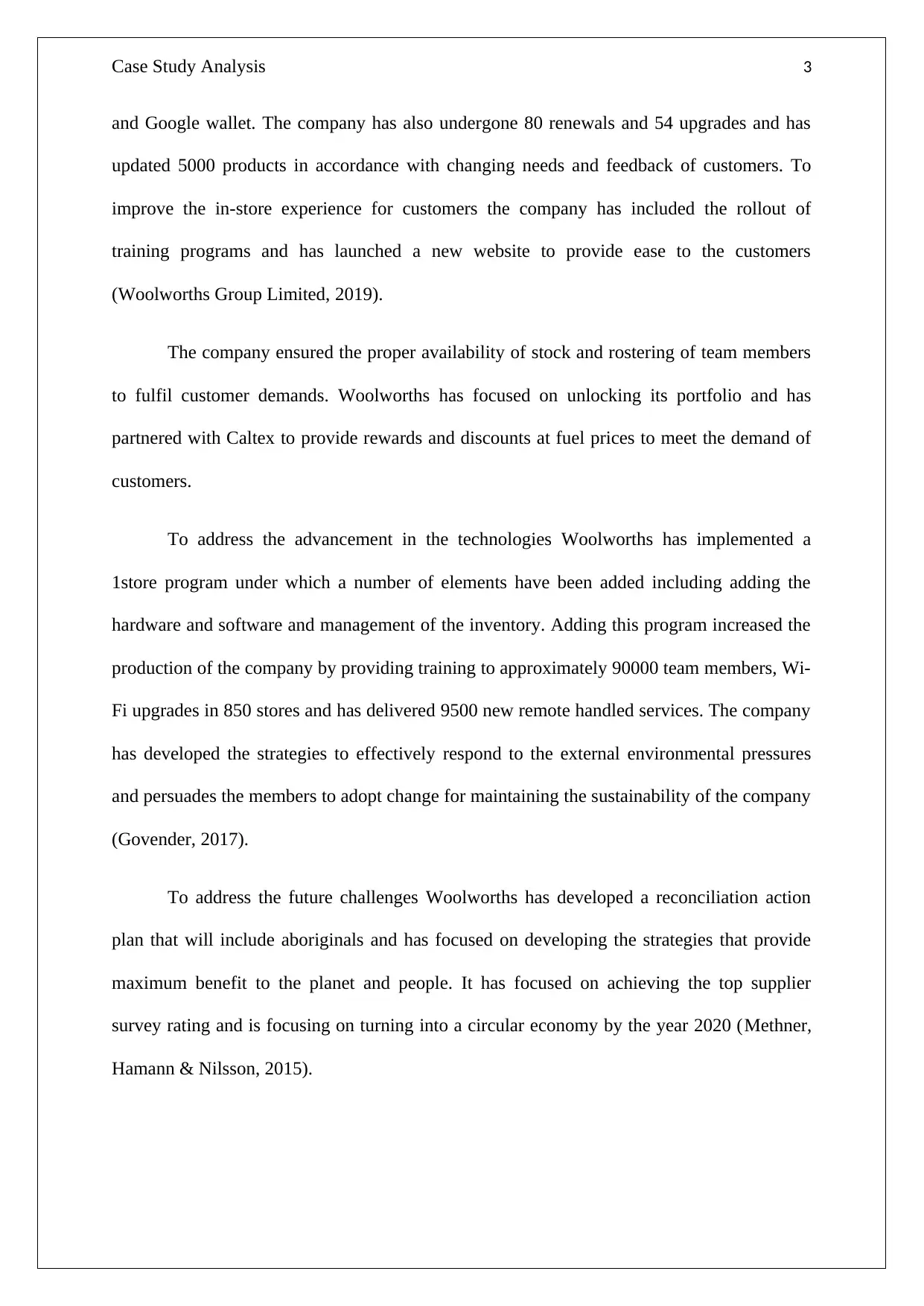
Case Study Analysis 3
and Google wallet. The company has also undergone 80 renewals and 54 upgrades and has
updated 5000 products in accordance with changing needs and feedback of customers. To
improve the in-store experience for customers the company has included the rollout of
training programs and has launched a new website to provide ease to the customers
(Woolworths Group Limited, 2019).
The company ensured the proper availability of stock and rostering of team members
to fulfil customer demands. Woolworths has focused on unlocking its portfolio and has
partnered with Caltex to provide rewards and discounts at fuel prices to meet the demand of
customers.
To address the advancement in the technologies Woolworths has implemented a
1store program under which a number of elements have been added including adding the
hardware and software and management of the inventory. Adding this program increased the
production of the company by providing training to approximately 90000 team members, Wi-
Fi upgrades in 850 stores and has delivered 9500 new remote handled services. The company
has developed the strategies to effectively respond to the external environmental pressures
and persuades the members to adopt change for maintaining the sustainability of the company
(Govender, 2017).
To address the future challenges Woolworths has developed a reconciliation action
plan that will include aboriginals and has focused on developing the strategies that provide
maximum benefit to the planet and people. It has focused on achieving the top supplier
survey rating and is focusing on turning into a circular economy by the year 2020 (Methner,
Hamann & Nilsson, 2015).
and Google wallet. The company has also undergone 80 renewals and 54 upgrades and has
updated 5000 products in accordance with changing needs and feedback of customers. To
improve the in-store experience for customers the company has included the rollout of
training programs and has launched a new website to provide ease to the customers
(Woolworths Group Limited, 2019).
The company ensured the proper availability of stock and rostering of team members
to fulfil customer demands. Woolworths has focused on unlocking its portfolio and has
partnered with Caltex to provide rewards and discounts at fuel prices to meet the demand of
customers.
To address the advancement in the technologies Woolworths has implemented a
1store program under which a number of elements have been added including adding the
hardware and software and management of the inventory. Adding this program increased the
production of the company by providing training to approximately 90000 team members, Wi-
Fi upgrades in 850 stores and has delivered 9500 new remote handled services. The company
has developed the strategies to effectively respond to the external environmental pressures
and persuades the members to adopt change for maintaining the sustainability of the company
(Govender, 2017).
To address the future challenges Woolworths has developed a reconciliation action
plan that will include aboriginals and has focused on developing the strategies that provide
maximum benefit to the planet and people. It has focused on achieving the top supplier
survey rating and is focusing on turning into a circular economy by the year 2020 (Methner,
Hamann & Nilsson, 2015).
Paraphrase This Document
Need a fresh take? Get an instant paraphrase of this document with our AI Paraphraser
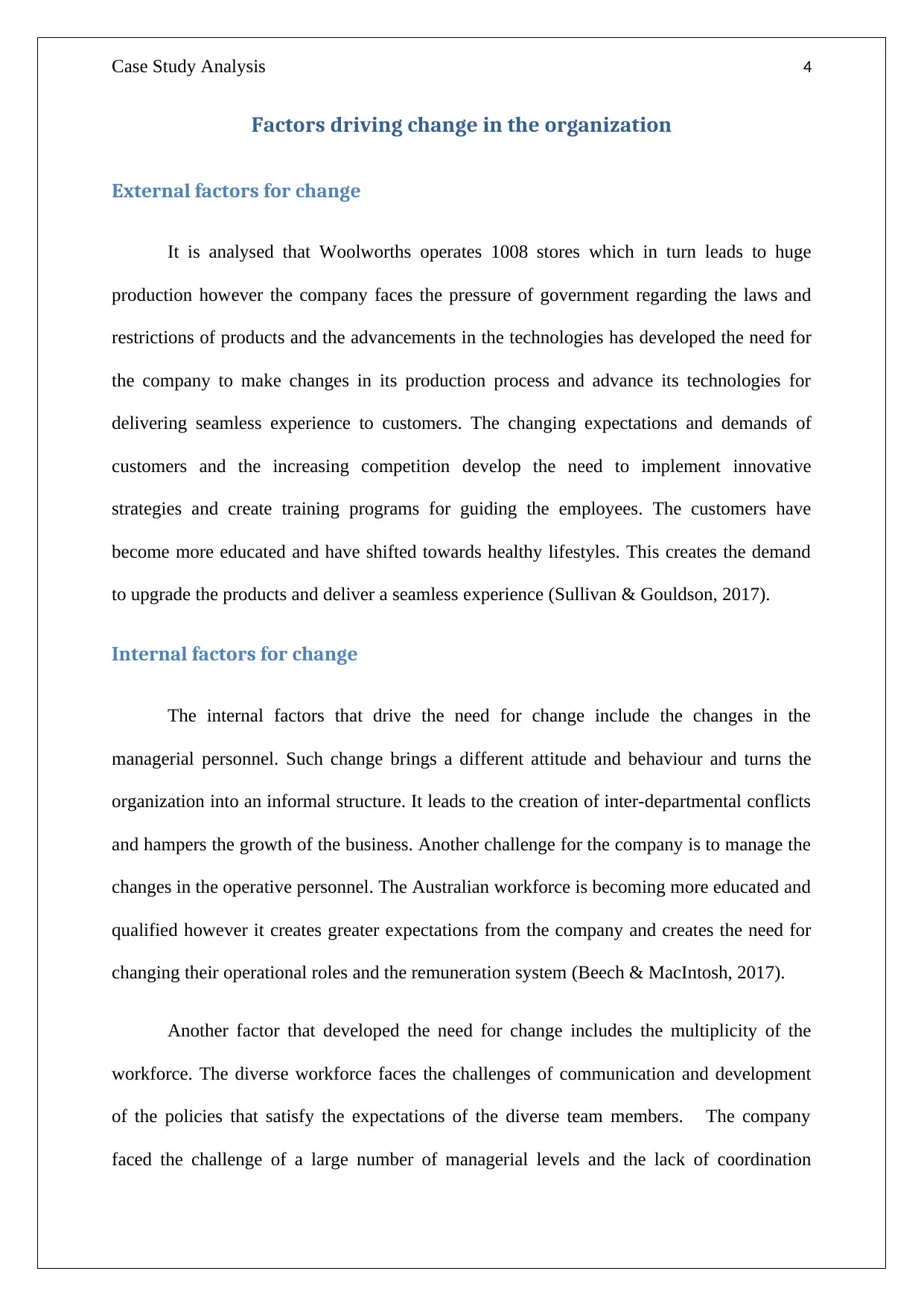
Case Study Analysis 4
Factors driving change in the organization
External factors for change
It is analysed that Woolworths operates 1008 stores which in turn leads to huge
production however the company faces the pressure of government regarding the laws and
restrictions of products and the advancements in the technologies has developed the need for
the company to make changes in its production process and advance its technologies for
delivering seamless experience to customers. The changing expectations and demands of
customers and the increasing competition develop the need to implement innovative
strategies and create training programs for guiding the employees. The customers have
become more educated and have shifted towards healthy lifestyles. This creates the demand
to upgrade the products and deliver a seamless experience (Sullivan & Gouldson, 2017).
Internal factors for change
The internal factors that drive the need for change include the changes in the
managerial personnel. Such change brings a different attitude and behaviour and turns the
organization into an informal structure. It leads to the creation of inter-departmental conflicts
and hampers the growth of the business. Another challenge for the company is to manage the
changes in the operative personnel. The Australian workforce is becoming more educated and
qualified however it creates greater expectations from the company and creates the need for
changing their operational roles and the remuneration system (Beech & MacIntosh, 2017).
Another factor that developed the need for change includes the multiplicity of the
workforce. The diverse workforce faces the challenges of communication and development
of the policies that satisfy the expectations of the diverse team members. The company
faced the challenge of a large number of managerial levels and the lack of coordination
Factors driving change in the organization
External factors for change
It is analysed that Woolworths operates 1008 stores which in turn leads to huge
production however the company faces the pressure of government regarding the laws and
restrictions of products and the advancements in the technologies has developed the need for
the company to make changes in its production process and advance its technologies for
delivering seamless experience to customers. The changing expectations and demands of
customers and the increasing competition develop the need to implement innovative
strategies and create training programs for guiding the employees. The customers have
become more educated and have shifted towards healthy lifestyles. This creates the demand
to upgrade the products and deliver a seamless experience (Sullivan & Gouldson, 2017).
Internal factors for change
The internal factors that drive the need for change include the changes in the
managerial personnel. Such change brings a different attitude and behaviour and turns the
organization into an informal structure. It leads to the creation of inter-departmental conflicts
and hampers the growth of the business. Another challenge for the company is to manage the
changes in the operative personnel. The Australian workforce is becoming more educated and
qualified however it creates greater expectations from the company and creates the need for
changing their operational roles and the remuneration system (Beech & MacIntosh, 2017).
Another factor that developed the need for change includes the multiplicity of the
workforce. The diverse workforce faces the challenges of communication and development
of the policies that satisfy the expectations of the diverse team members. The company
faced the challenge of a large number of managerial levels and the lack of coordination
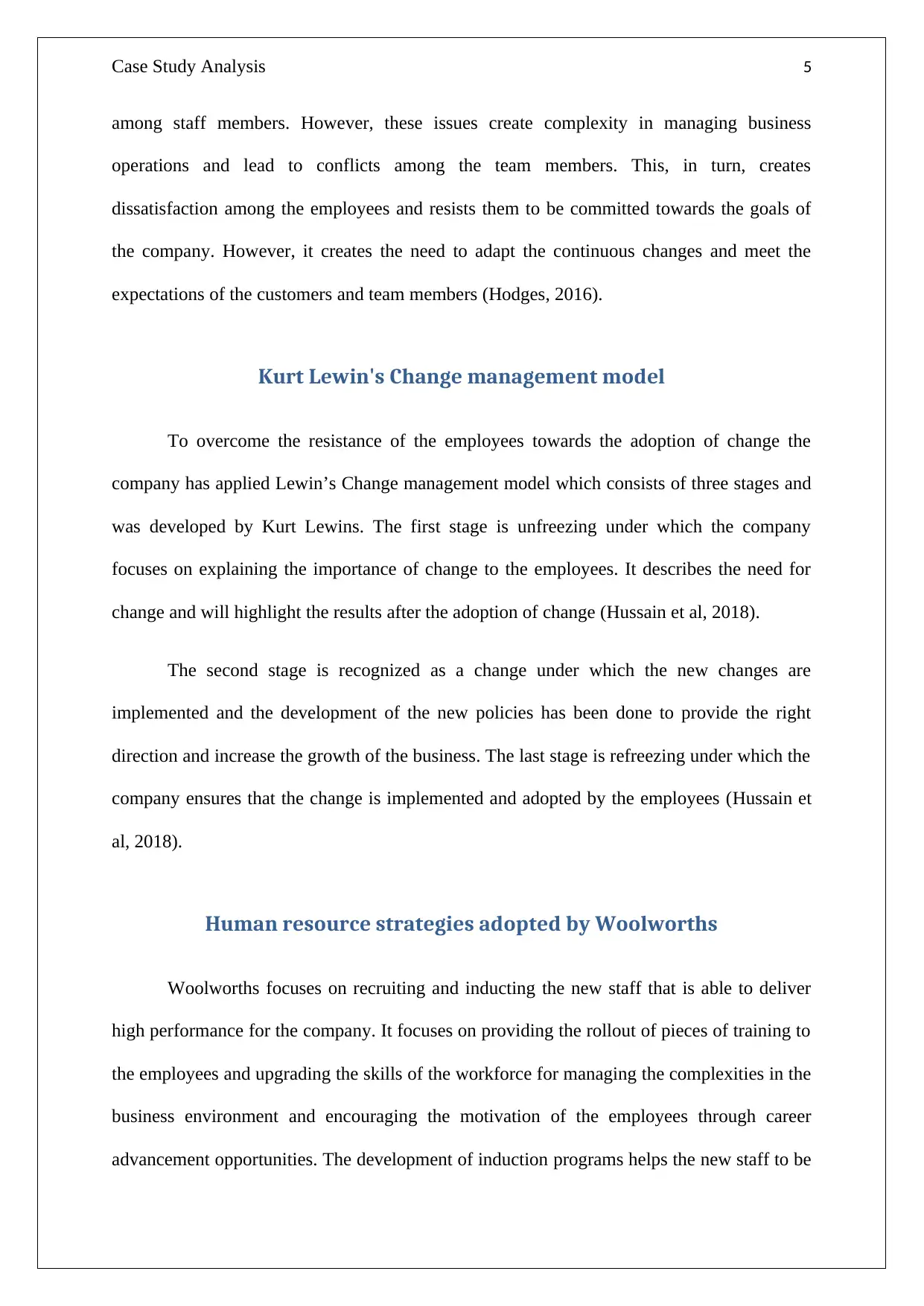
Case Study Analysis 5
among staff members. However, these issues create complexity in managing business
operations and lead to conflicts among the team members. This, in turn, creates
dissatisfaction among the employees and resists them to be committed towards the goals of
the company. However, it creates the need to adapt the continuous changes and meet the
expectations of the customers and team members (Hodges, 2016).
Kurt Lewin's Change management model
To overcome the resistance of the employees towards the adoption of change the
company has applied Lewin’s Change management model which consists of three stages and
was developed by Kurt Lewins. The first stage is unfreezing under which the company
focuses on explaining the importance of change to the employees. It describes the need for
change and will highlight the results after the adoption of change (Hussain et al, 2018).
The second stage is recognized as a change under which the new changes are
implemented and the development of the new policies has been done to provide the right
direction and increase the growth of the business. The last stage is refreezing under which the
company ensures that the change is implemented and adopted by the employees (Hussain et
al, 2018).
Human resource strategies adopted by Woolworths
Woolworths focuses on recruiting and inducting the new staff that is able to deliver
high performance for the company. It focuses on providing the rollout of pieces of training to
the employees and upgrading the skills of the workforce for managing the complexities in the
business environment and encouraging the motivation of the employees through career
advancement opportunities. The development of induction programs helps the new staff to be
among staff members. However, these issues create complexity in managing business
operations and lead to conflicts among the team members. This, in turn, creates
dissatisfaction among the employees and resists them to be committed towards the goals of
the company. However, it creates the need to adapt the continuous changes and meet the
expectations of the customers and team members (Hodges, 2016).
Kurt Lewin's Change management model
To overcome the resistance of the employees towards the adoption of change the
company has applied Lewin’s Change management model which consists of three stages and
was developed by Kurt Lewins. The first stage is unfreezing under which the company
focuses on explaining the importance of change to the employees. It describes the need for
change and will highlight the results after the adoption of change (Hussain et al, 2018).
The second stage is recognized as a change under which the new changes are
implemented and the development of the new policies has been done to provide the right
direction and increase the growth of the business. The last stage is refreezing under which the
company ensures that the change is implemented and adopted by the employees (Hussain et
al, 2018).
Human resource strategies adopted by Woolworths
Woolworths focuses on recruiting and inducting the new staff that is able to deliver
high performance for the company. It focuses on providing the rollout of pieces of training to
the employees and upgrading the skills of the workforce for managing the complexities in the
business environment and encouraging the motivation of the employees through career
advancement opportunities. The development of induction programs helps the new staff to be
⊘ This is a preview!⊘
Do you want full access?
Subscribe today to unlock all pages.

Trusted by 1+ million students worldwide
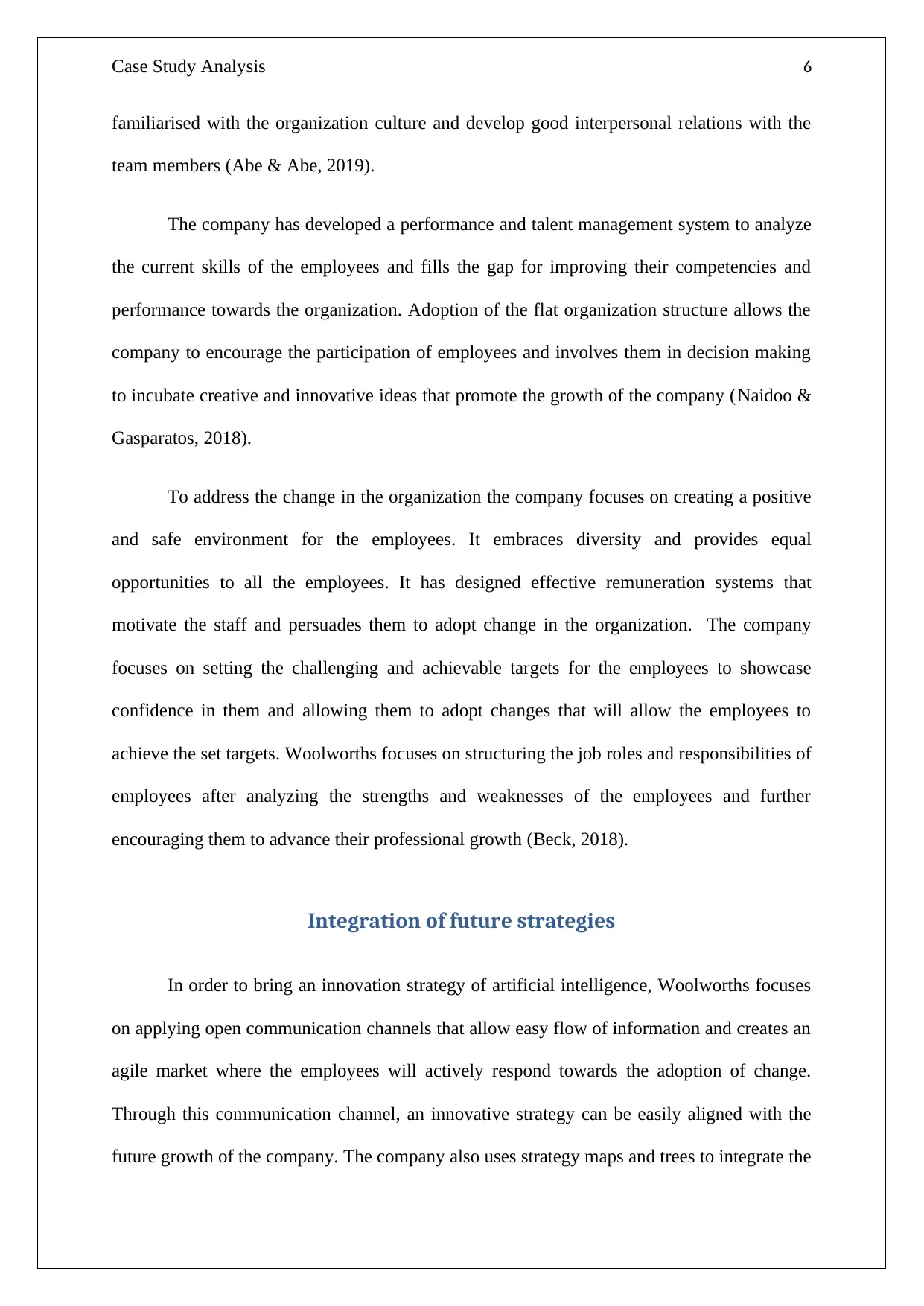
Case Study Analysis 6
familiarised with the organization culture and develop good interpersonal relations with the
team members (Abe & Abe, 2019).
The company has developed a performance and talent management system to analyze
the current skills of the employees and fills the gap for improving their competencies and
performance towards the organization. Adoption of the flat organization structure allows the
company to encourage the participation of employees and involves them in decision making
to incubate creative and innovative ideas that promote the growth of the company (Naidoo &
Gasparatos, 2018).
To address the change in the organization the company focuses on creating a positive
and safe environment for the employees. It embraces diversity and provides equal
opportunities to all the employees. It has designed effective remuneration systems that
motivate the staff and persuades them to adopt change in the organization. The company
focuses on setting the challenging and achievable targets for the employees to showcase
confidence in them and allowing them to adopt changes that will allow the employees to
achieve the set targets. Woolworths focuses on structuring the job roles and responsibilities of
employees after analyzing the strengths and weaknesses of the employees and further
encouraging them to advance their professional growth (Beck, 2018).
Integration of future strategies
In order to bring an innovation strategy of artificial intelligence, Woolworths focuses
on applying open communication channels that allow easy flow of information and creates an
agile market where the employees will actively respond towards the adoption of change.
Through this communication channel, an innovative strategy can be easily aligned with the
future growth of the company. The company also uses strategy maps and trees to integrate the
familiarised with the organization culture and develop good interpersonal relations with the
team members (Abe & Abe, 2019).
The company has developed a performance and talent management system to analyze
the current skills of the employees and fills the gap for improving their competencies and
performance towards the organization. Adoption of the flat organization structure allows the
company to encourage the participation of employees and involves them in decision making
to incubate creative and innovative ideas that promote the growth of the company (Naidoo &
Gasparatos, 2018).
To address the change in the organization the company focuses on creating a positive
and safe environment for the employees. It embraces diversity and provides equal
opportunities to all the employees. It has designed effective remuneration systems that
motivate the staff and persuades them to adopt change in the organization. The company
focuses on setting the challenging and achievable targets for the employees to showcase
confidence in them and allowing them to adopt changes that will allow the employees to
achieve the set targets. Woolworths focuses on structuring the job roles and responsibilities of
employees after analyzing the strengths and weaknesses of the employees and further
encouraging them to advance their professional growth (Beck, 2018).
Integration of future strategies
In order to bring an innovation strategy of artificial intelligence, Woolworths focuses
on applying open communication channels that allow easy flow of information and creates an
agile market where the employees will actively respond towards the adoption of change.
Through this communication channel, an innovative strategy can be easily aligned with the
future growth of the company. The company also uses strategy maps and trees to integrate the
Paraphrase This Document
Need a fresh take? Get an instant paraphrase of this document with our AI Paraphraser
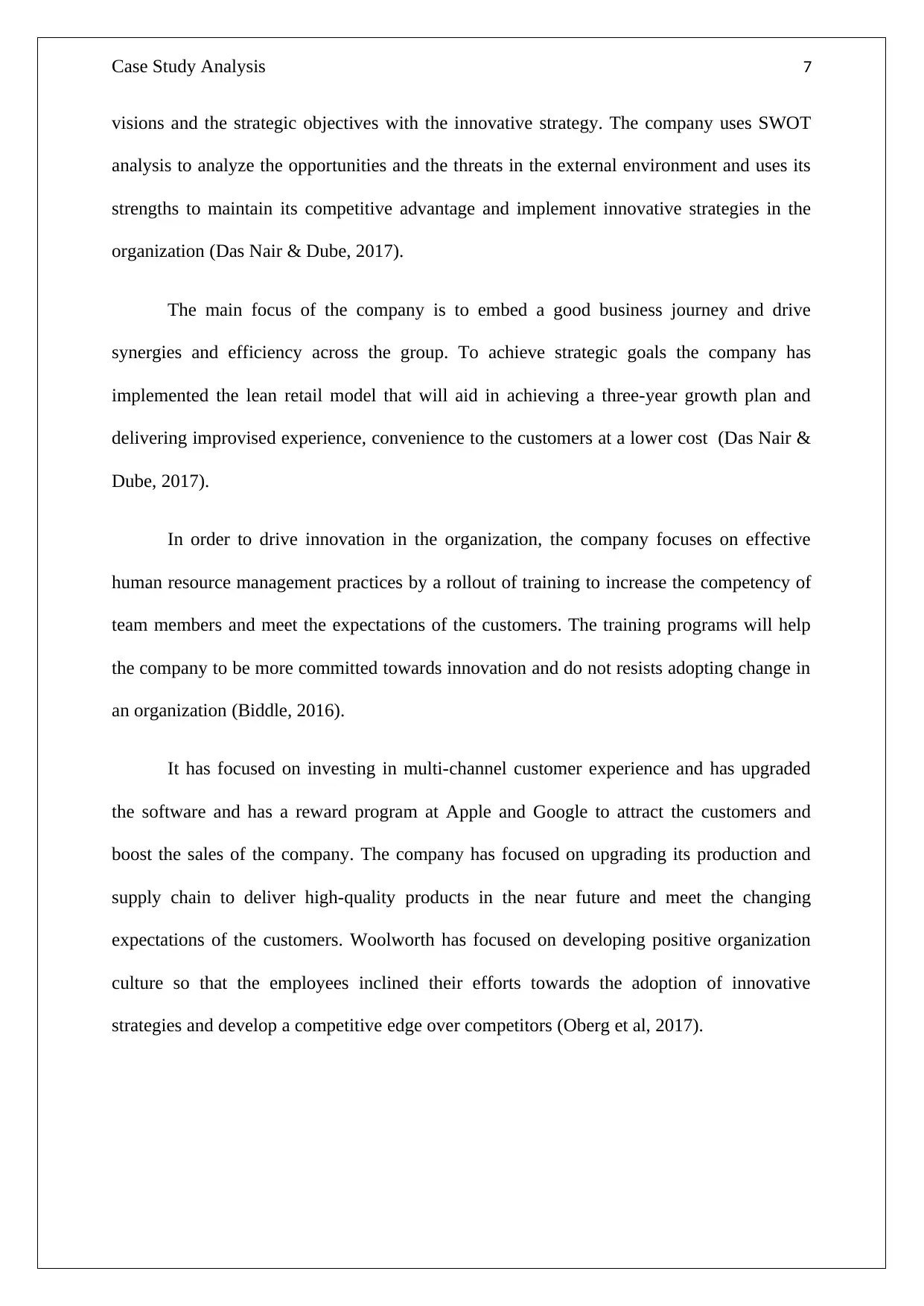
Case Study Analysis 7
visions and the strategic objectives with the innovative strategy. The company uses SWOT
analysis to analyze the opportunities and the threats in the external environment and uses its
strengths to maintain its competitive advantage and implement innovative strategies in the
organization (Das Nair & Dube, 2017).
The main focus of the company is to embed a good business journey and drive
synergies and efficiency across the group. To achieve strategic goals the company has
implemented the lean retail model that will aid in achieving a three-year growth plan and
delivering improvised experience, convenience to the customers at a lower cost (Das Nair &
Dube, 2017).
In order to drive innovation in the organization, the company focuses on effective
human resource management practices by a rollout of training to increase the competency of
team members and meet the expectations of the customers. The training programs will help
the company to be more committed towards innovation and do not resists adopting change in
an organization (Biddle, 2016).
It has focused on investing in multi-channel customer experience and has upgraded
the software and has a reward program at Apple and Google to attract the customers and
boost the sales of the company. The company has focused on upgrading its production and
supply chain to deliver high-quality products in the near future and meet the changing
expectations of the customers. Woolworth has focused on developing positive organization
culture so that the employees inclined their efforts towards the adoption of innovative
strategies and develop a competitive edge over competitors (Oberg et al, 2017).
visions and the strategic objectives with the innovative strategy. The company uses SWOT
analysis to analyze the opportunities and the threats in the external environment and uses its
strengths to maintain its competitive advantage and implement innovative strategies in the
organization (Das Nair & Dube, 2017).
The main focus of the company is to embed a good business journey and drive
synergies and efficiency across the group. To achieve strategic goals the company has
implemented the lean retail model that will aid in achieving a three-year growth plan and
delivering improvised experience, convenience to the customers at a lower cost (Das Nair &
Dube, 2017).
In order to drive innovation in the organization, the company focuses on effective
human resource management practices by a rollout of training to increase the competency of
team members and meet the expectations of the customers. The training programs will help
the company to be more committed towards innovation and do not resists adopting change in
an organization (Biddle, 2016).
It has focused on investing in multi-channel customer experience and has upgraded
the software and has a reward program at Apple and Google to attract the customers and
boost the sales of the company. The company has focused on upgrading its production and
supply chain to deliver high-quality products in the near future and meet the changing
expectations of the customers. Woolworth has focused on developing positive organization
culture so that the employees inclined their efforts towards the adoption of innovative
strategies and develop a competitive edge over competitors (Oberg et al, 2017).
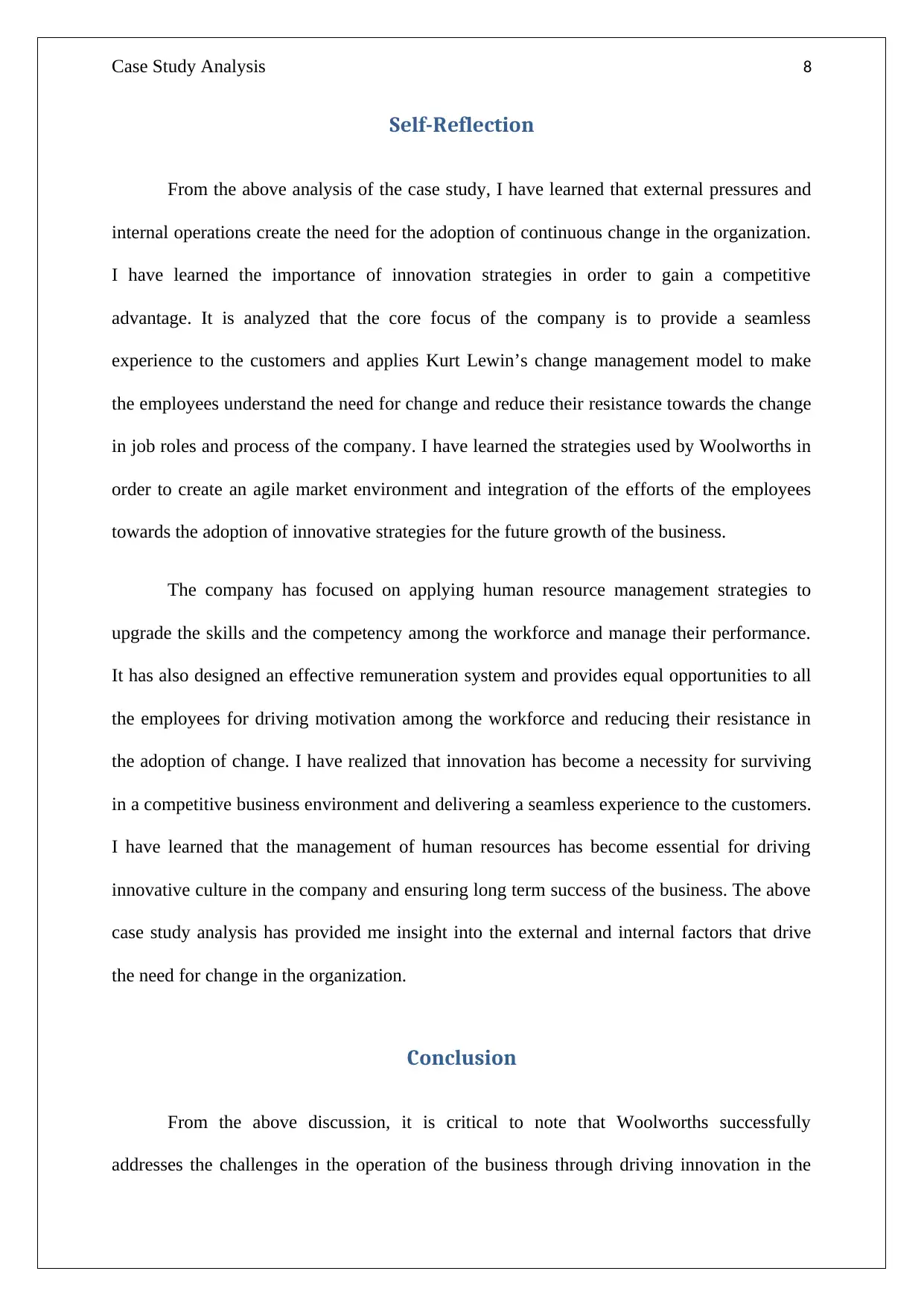
Case Study Analysis 8
Self-Reflection
From the above analysis of the case study, I have learned that external pressures and
internal operations create the need for the adoption of continuous change in the organization.
I have learned the importance of innovation strategies in order to gain a competitive
advantage. It is analyzed that the core focus of the company is to provide a seamless
experience to the customers and applies Kurt Lewin’s change management model to make
the employees understand the need for change and reduce their resistance towards the change
in job roles and process of the company. I have learned the strategies used by Woolworths in
order to create an agile market environment and integration of the efforts of the employees
towards the adoption of innovative strategies for the future growth of the business.
The company has focused on applying human resource management strategies to
upgrade the skills and the competency among the workforce and manage their performance.
It has also designed an effective remuneration system and provides equal opportunities to all
the employees for driving motivation among the workforce and reducing their resistance in
the adoption of change. I have realized that innovation has become a necessity for surviving
in a competitive business environment and delivering a seamless experience to the customers.
I have learned that the management of human resources has become essential for driving
innovative culture in the company and ensuring long term success of the business. The above
case study analysis has provided me insight into the external and internal factors that drive
the need for change in the organization.
Conclusion
From the above discussion, it is critical to note that Woolworths successfully
addresses the challenges in the operation of the business through driving innovation in the
Self-Reflection
From the above analysis of the case study, I have learned that external pressures and
internal operations create the need for the adoption of continuous change in the organization.
I have learned the importance of innovation strategies in order to gain a competitive
advantage. It is analyzed that the core focus of the company is to provide a seamless
experience to the customers and applies Kurt Lewin’s change management model to make
the employees understand the need for change and reduce their resistance towards the change
in job roles and process of the company. I have learned the strategies used by Woolworths in
order to create an agile market environment and integration of the efforts of the employees
towards the adoption of innovative strategies for the future growth of the business.
The company has focused on applying human resource management strategies to
upgrade the skills and the competency among the workforce and manage their performance.
It has also designed an effective remuneration system and provides equal opportunities to all
the employees for driving motivation among the workforce and reducing their resistance in
the adoption of change. I have realized that innovation has become a necessity for surviving
in a competitive business environment and delivering a seamless experience to the customers.
I have learned that the management of human resources has become essential for driving
innovative culture in the company and ensuring long term success of the business. The above
case study analysis has provided me insight into the external and internal factors that drive
the need for change in the organization.
Conclusion
From the above discussion, it is critical to note that Woolworths successfully
addresses the challenges in the operation of the business through driving innovation in the
⊘ This is a preview!⊘
Do you want full access?
Subscribe today to unlock all pages.

Trusted by 1+ million students worldwide
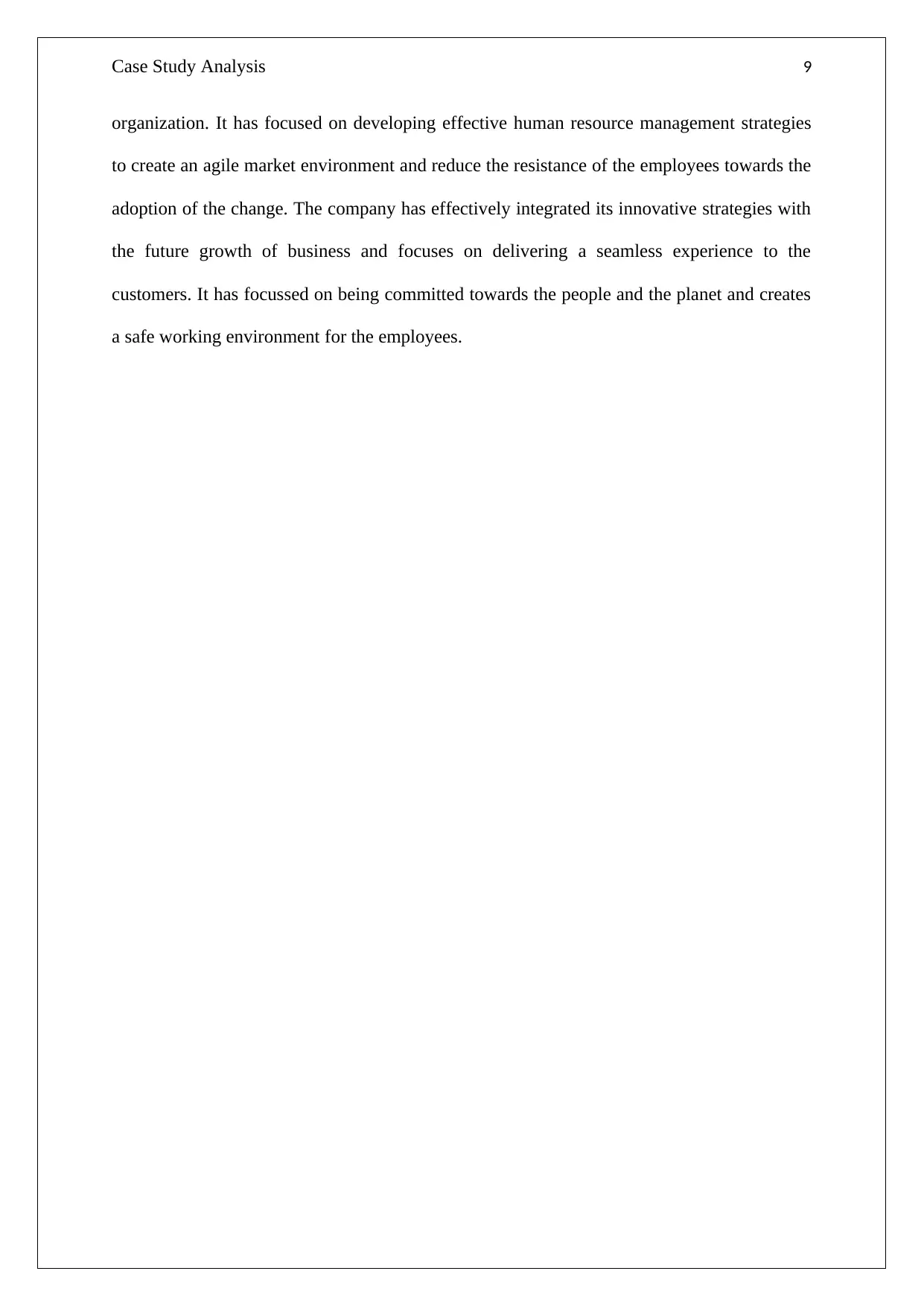
Case Study Analysis 9
organization. It has focused on developing effective human resource management strategies
to create an agile market environment and reduce the resistance of the employees towards the
adoption of the change. The company has effectively integrated its innovative strategies with
the future growth of business and focuses on delivering a seamless experience to the
customers. It has focussed on being committed towards the people and the planet and creates
a safe working environment for the employees.
organization. It has focused on developing effective human resource management strategies
to create an agile market environment and reduce the resistance of the employees towards the
adoption of the change. The company has effectively integrated its innovative strategies with
the future growth of business and focuses on delivering a seamless experience to the
customers. It has focussed on being committed towards the people and the planet and creates
a safe working environment for the employees.
Paraphrase This Document
Need a fresh take? Get an instant paraphrase of this document with our AI Paraphraser
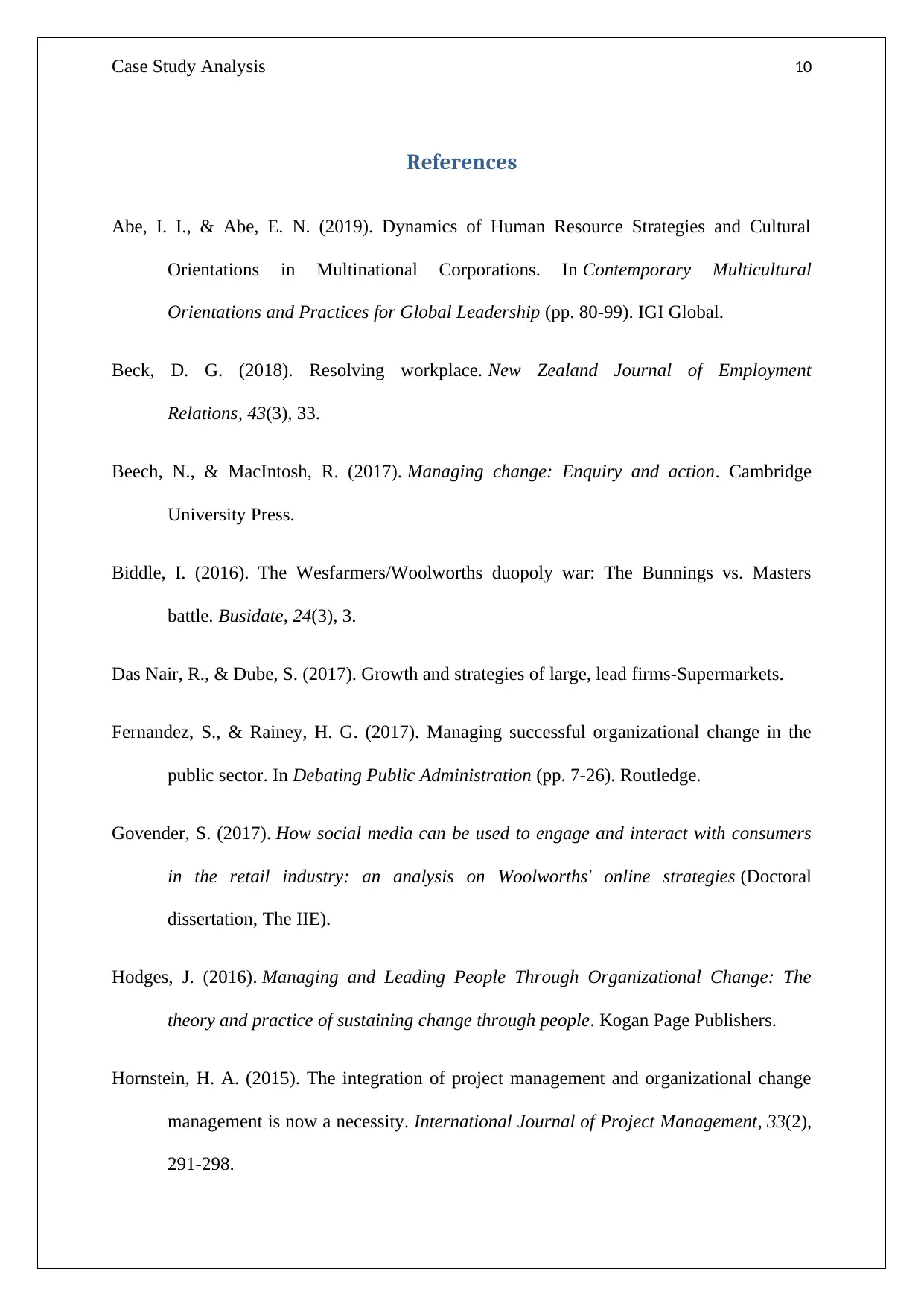
Case Study Analysis 10
References
Abe, I. I., & Abe, E. N. (2019). Dynamics of Human Resource Strategies and Cultural
Orientations in Multinational Corporations. In Contemporary Multicultural
Orientations and Practices for Global Leadership (pp. 80-99). IGI Global.
Beck, D. G. (2018). Resolving workplace. New Zealand Journal of Employment
Relations, 43(3), 33.
Beech, N., & MacIntosh, R. (2017). Managing change: Enquiry and action. Cambridge
University Press.
Biddle, I. (2016). The Wesfarmers/Woolworths duopoly war: The Bunnings vs. Masters
battle. Busidate, 24(3), 3.
Das Nair, R., & Dube, S. (2017). Growth and strategies of large, lead firms-Supermarkets.
Fernandez, S., & Rainey, H. G. (2017). Managing successful organizational change in the
public sector. In Debating Public Administration (pp. 7-26). Routledge.
Govender, S. (2017). How social media can be used to engage and interact with consumers
in the retail industry: an analysis on Woolworths' online strategies (Doctoral
dissertation, The IIE).
Hodges, J. (2016). Managing and Leading People Through Organizational Change: The
theory and practice of sustaining change through people. Kogan Page Publishers.
Hornstein, H. A. (2015). The integration of project management and organizational change
management is now a necessity. International Journal of Project Management, 33(2),
291-298.
References
Abe, I. I., & Abe, E. N. (2019). Dynamics of Human Resource Strategies and Cultural
Orientations in Multinational Corporations. In Contemporary Multicultural
Orientations and Practices for Global Leadership (pp. 80-99). IGI Global.
Beck, D. G. (2018). Resolving workplace. New Zealand Journal of Employment
Relations, 43(3), 33.
Beech, N., & MacIntosh, R. (2017). Managing change: Enquiry and action. Cambridge
University Press.
Biddle, I. (2016). The Wesfarmers/Woolworths duopoly war: The Bunnings vs. Masters
battle. Busidate, 24(3), 3.
Das Nair, R., & Dube, S. (2017). Growth and strategies of large, lead firms-Supermarkets.
Fernandez, S., & Rainey, H. G. (2017). Managing successful organizational change in the
public sector. In Debating Public Administration (pp. 7-26). Routledge.
Govender, S. (2017). How social media can be used to engage and interact with consumers
in the retail industry: an analysis on Woolworths' online strategies (Doctoral
dissertation, The IIE).
Hodges, J. (2016). Managing and Leading People Through Organizational Change: The
theory and practice of sustaining change through people. Kogan Page Publishers.
Hornstein, H. A. (2015). The integration of project management and organizational change
management is now a necessity. International Journal of Project Management, 33(2),
291-298.
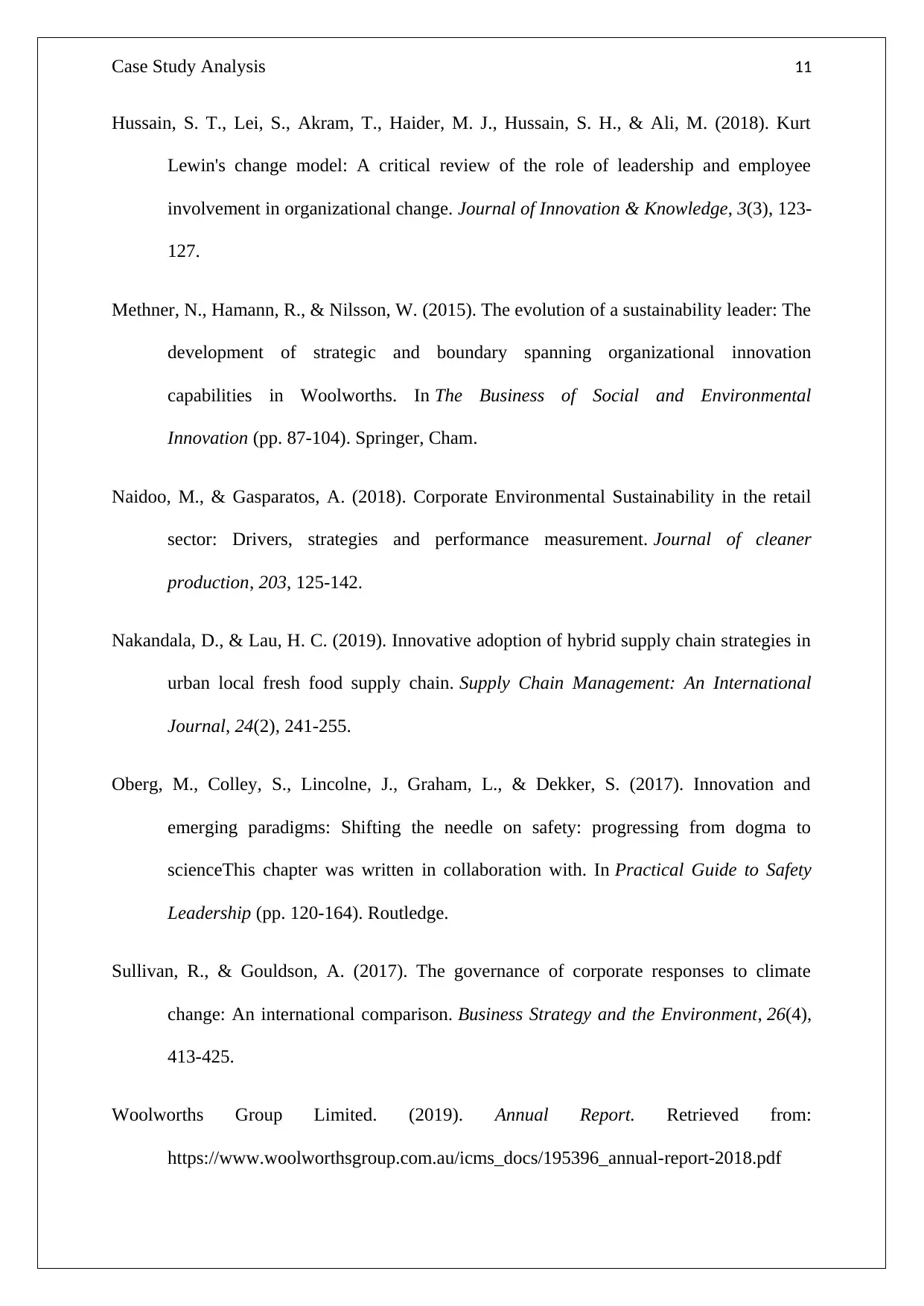
Case Study Analysis 11
Hussain, S. T., Lei, S., Akram, T., Haider, M. J., Hussain, S. H., & Ali, M. (2018). Kurt
Lewin's change model: A critical review of the role of leadership and employee
involvement in organizational change. Journal of Innovation & Knowledge, 3(3), 123-
127.
Methner, N., Hamann, R., & Nilsson, W. (2015). The evolution of a sustainability leader: The
development of strategic and boundary spanning organizational innovation
capabilities in Woolworths. In The Business of Social and Environmental
Innovation (pp. 87-104). Springer, Cham.
Naidoo, M., & Gasparatos, A. (2018). Corporate Environmental Sustainability in the retail
sector: Drivers, strategies and performance measurement. Journal of cleaner
production, 203, 125-142.
Nakandala, D., & Lau, H. C. (2019). Innovative adoption of hybrid supply chain strategies in
urban local fresh food supply chain. Supply Chain Management: An International
Journal, 24(2), 241-255.
Oberg, M., Colley, S., Lincolne, J., Graham, L., & Dekker, S. (2017). Innovation and
emerging paradigms: Shifting the needle on safety: progressing from dogma to
scienceThis chapter was written in collaboration with. In Practical Guide to Safety
Leadership (pp. 120-164). Routledge.
Sullivan, R., & Gouldson, A. (2017). The governance of corporate responses to climate
change: An international comparison. Business Strategy and the Environment, 26(4),
413-425.
Woolworths Group Limited. (2019). Annual Report. Retrieved from:
https://www.woolworthsgroup.com.au/icms_docs/195396_annual-report-2018.pdf
Hussain, S. T., Lei, S., Akram, T., Haider, M. J., Hussain, S. H., & Ali, M. (2018). Kurt
Lewin's change model: A critical review of the role of leadership and employee
involvement in organizational change. Journal of Innovation & Knowledge, 3(3), 123-
127.
Methner, N., Hamann, R., & Nilsson, W. (2015). The evolution of a sustainability leader: The
development of strategic and boundary spanning organizational innovation
capabilities in Woolworths. In The Business of Social and Environmental
Innovation (pp. 87-104). Springer, Cham.
Naidoo, M., & Gasparatos, A. (2018). Corporate Environmental Sustainability in the retail
sector: Drivers, strategies and performance measurement. Journal of cleaner
production, 203, 125-142.
Nakandala, D., & Lau, H. C. (2019). Innovative adoption of hybrid supply chain strategies in
urban local fresh food supply chain. Supply Chain Management: An International
Journal, 24(2), 241-255.
Oberg, M., Colley, S., Lincolne, J., Graham, L., & Dekker, S. (2017). Innovation and
emerging paradigms: Shifting the needle on safety: progressing from dogma to
scienceThis chapter was written in collaboration with. In Practical Guide to Safety
Leadership (pp. 120-164). Routledge.
Sullivan, R., & Gouldson, A. (2017). The governance of corporate responses to climate
change: An international comparison. Business Strategy and the Environment, 26(4),
413-425.
Woolworths Group Limited. (2019). Annual Report. Retrieved from:
https://www.woolworthsgroup.com.au/icms_docs/195396_annual-report-2018.pdf
⊘ This is a preview!⊘
Do you want full access?
Subscribe today to unlock all pages.

Trusted by 1+ million students worldwide
1 out of 12
Related Documents
Your All-in-One AI-Powered Toolkit for Academic Success.
+13062052269
info@desklib.com
Available 24*7 on WhatsApp / Email
![[object Object]](/_next/static/media/star-bottom.7253800d.svg)
Unlock your academic potential
Copyright © 2020–2025 A2Z Services. All Rights Reserved. Developed and managed by ZUCOL.





